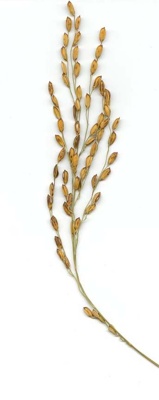Diseases
Phyllosticta oryzaecola Hara - Phyllosticta Leaf Spot of Rice.
Systematic position.
Division Eumycota, subdivision Deuteromycotina, class Coelomycetes, order Sphaeropsidales, family Sphaerioidaceae, genus Phyllosticta.Biological group.
Hemibiotrophic parasite.Morphology and biology.
Disease usually appears right before the emergence of panicle on leaves and 2-3 weeks after panicle emergence on glumes. Tips of leaves over 3-5 cm become whitish, dry, translucent. On glumes the spots are lengthened, dark brown, then whitish. Pycnidia are numerous, light brown, globose, 75-125 microns in diameter; stoma 10-18 microns. Pycnopores cylindrical, oval, ovoid, colorless, rounded at the ends, 6-9 x 3 microns. The fungus winters on vegetative residues. Distribution during a season occurs by pycnospores.Distribution.
In Russia it is found in the Primorskii Territory.Ecology.
Not investigated.Economic significance.
With strong damage of panicles the grain remains puny, and at early infection the seeds may not form. As the data on harmfulness of this disease is absent in literature, the disease has no essential influence on crop yield. Control measures include eradication of residues and treatment of seeds with fungicides before sowing.Reference citations:
Abramov I.N. 1939. The diseases of agricultural plants in the Far East. Khabarovsk: Dalgiz. 292 p. (In Russian)Ainsworth G.C. 1971. Ainsworth & Bisby's Dictionary of the fungi. Sixth edition. Kew, Surrey: Commonwealth Mycological Institute. 663 p.
Dorofeeva L.L., Kodyakov A.A., Kratenko V.P., Lebedev M.B., Motovilin A.A., Tikhonova N.A. 1992. Fungal diseases of rice. Tashkent: FAN. 94 p. (In Russian)
© Gasich E.L.


